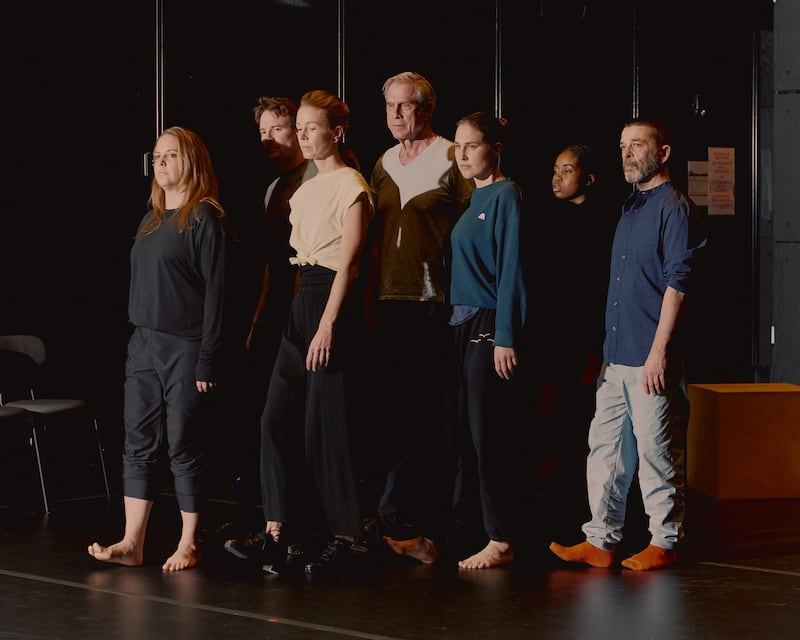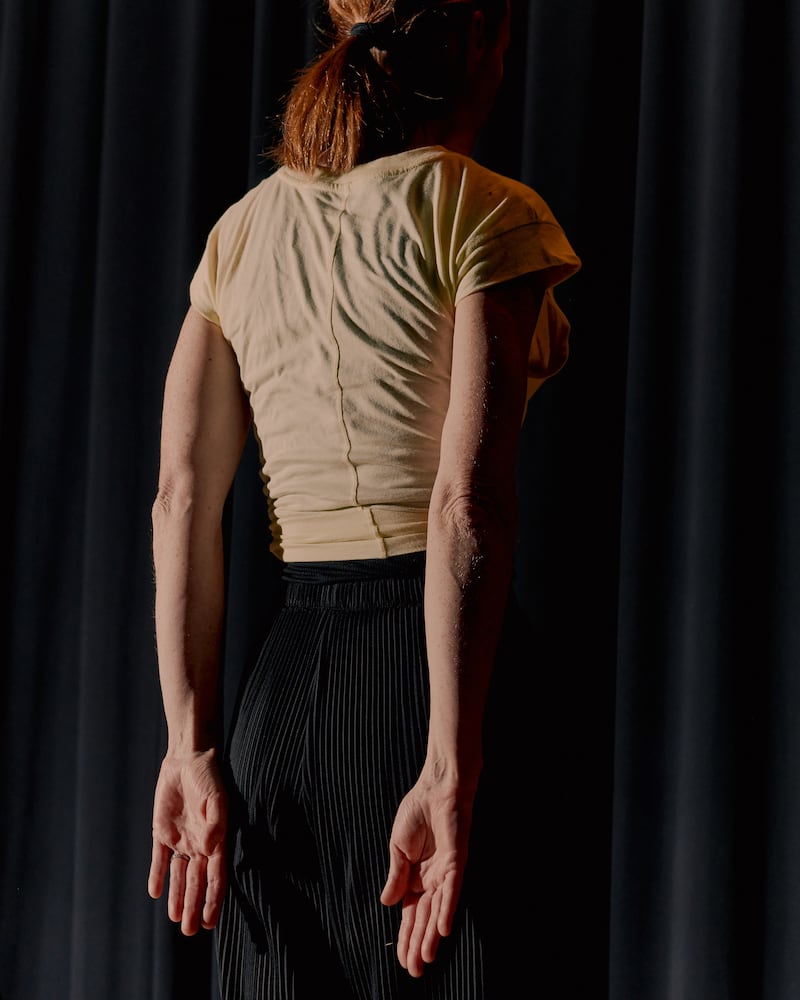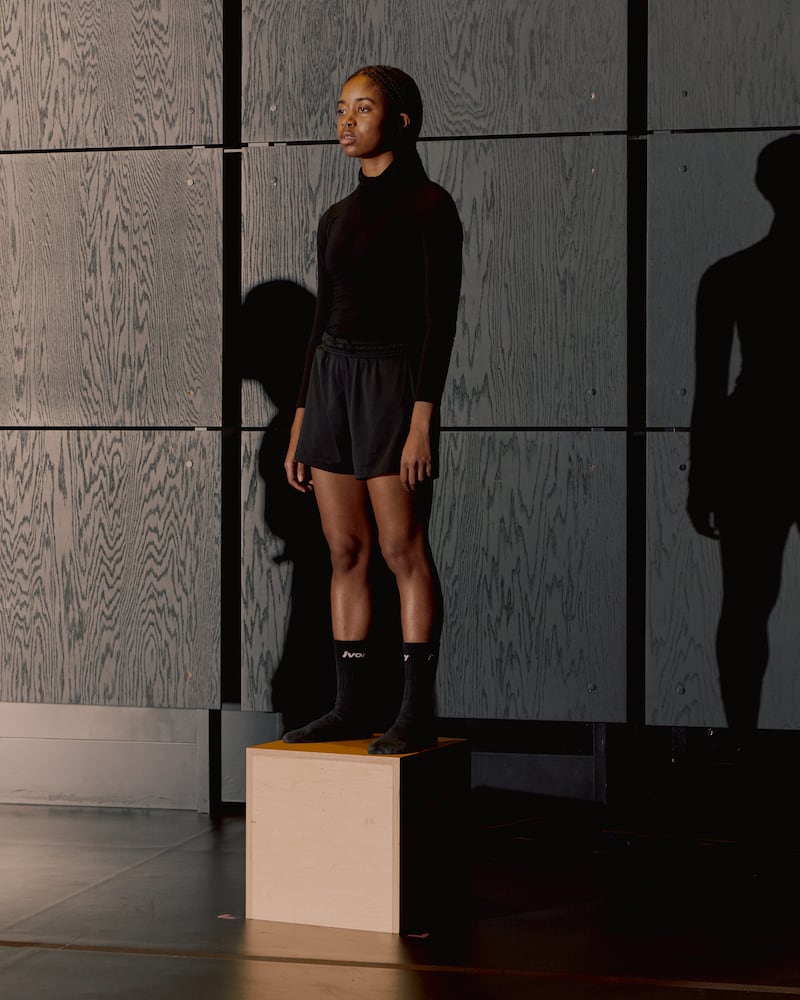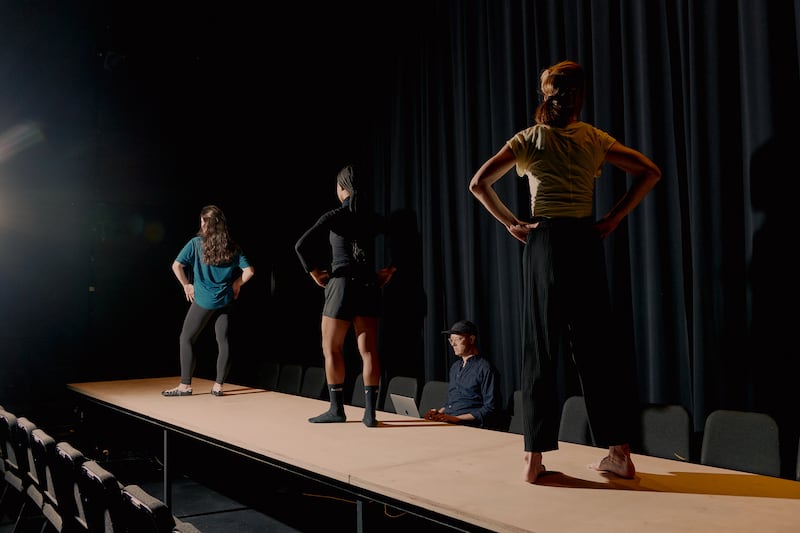Halfway through Jean Butler’s What We Hold, the audience is invited to sit at a lo ng table surrounded by 50 chairs, as if at a wedding banquet. Instead of place settings, three dancers are before them. As the audience settles in, voices begin to float through the room, like snatches of lost conversations.
“Dancing was the poor man’s game, you know,” says one recorded voice. Another: “It was like he was telling you a story with his feet.” As the voices recall the past, the three dancers enact a kind of ritual. First, they stand casually. Then, with great precision, they slide a foot forward, pointing their toes. Their postures change – shoulders back, heads high, arms straight at their sides, hands in loose fists. A transformation happens: They are not just dancers but Irish dancers.
“That’s the very first thing we learned as kids, that posture,” Butler says after a rehearsal. It is something all Irish dancers hold in their bodies, such as first position in ballet.
For fans of Irish dancing, Butler – one of the dancers on the table and the creator of the show, which is at the Irish Arts Center in New York from February 14th until March 3rd – represents the epitome of the genre. As a star of Riverdance, she delighted audiences with the clarity, delicacy and airiness of her dancing. And it is because of that show, which premiered at Eurovision in 1995 and continues to tour, that perceptions about Irish dancing changed; it became something it had never been seen as before: exciting, even sexy.
READ MORE

Butler walked away from all that in the early 2000s and remade herself as a contemporary dancer and choreographer, working in an introspective, pared-down, almost minimalist mode. Now, after years of investigating a different way of moving, she has returned to Irish dance with What We Hold, this time through a different, more inquiring lens.
“It’s almost like every moment in the show represents something I’ve experienced as a dancer,” Butler says, “and I hadn’t even realised until I tried to articulate it”.
In 2018, she began a sprawling oral history project, Our Steps, Our Story, in partnership with the Jerome Robbins Dance Division of the New York Public Library. She recorded the stories of several generations of Irish dancers and filmed them as they demonstrated dances. To move their stories into the present, she also asked them to teach their old dances to a new generation of young performers.
[ The Road to Riverdance: Lively account of seismic changes in Irish societyOpens in new window ]
Nothing like it had been done before, says Linda Murray, the curator of the library’s dance division, who is Irish – and whose father and grandparents were competitive Irish dancers. “There’s almost nothing I can’t find” at the library, Murray says in an interview, “except for my own culture. There’s almost no Irish dance material in the collection. We wanted to change that”.

The voices spliced together in the table scene come from that archive. They are part of a tapestry of sounds, melodies, rhythm and electronics that have been woven together into a sound sculpture by Ryan Seaton and Andrew Rumpler.
The theme of retrieval and transformation runs through What We Hold, which premiered at the Dublin Theatre Festival in 2022, with the audience guided through several floors of a Georgian mansion. In New York, at the Irish Arts Centre’s black box theatre, it had to be rethought. The space is subdivided into separate areas through which the audience moves.
In the show’s four scenes, Butler weaves steps and postures from the past, but she also deconstructs them to their barest essentials: a position of the foot, a crossing of one knee in front of the other, a rapid 1-2-3 step that carries a dancer fleetly across the floor.
Butler’s cast of eight, ages 15 to 70, some Irish, some Irish American, includes four former Riverdance performers and a dancer with no ties to Ireland who took up Irish dance simply because she thought it looked fun.
The first thing the audience sees – and hears – is James Greenan (33) performing an extended step dance in hard shoes on a platform in front of two mirrors. His footwork is hard-driving and virtuosic, a kind of rhythmic theme with variations. Greenan is a former world champion on the competitive Irish dance circuit who went on to have a leading role in Riverdance for 12 years.
The experience of practising in front of a mirror, alone, is one every dancer knows. But Greenan says dancing a cappella, for 10 minutes, in front of dozens of people who stand just inches away, presented challenges.
“I had to work hard to sit in that simplicity and phrasing of texture and tone for that long,” he says. “It’s hard to strip back everything and find what’s underneath.”
The dancers’ experiences and identities are woven through the show. Kaitlyn Sardin (26) who dances on the table with Butler, is Black and from Orlando, Florida; she first encountered Irish dancing during the intermission of one of her ballet recitals at the age of 7. “I loved the fact that the Irish dancers made noise,” she says in an interview, “and being able to hear the rhythm because of the hard shoes, I realised I could become my own drum”.
In What We Hold, Sardin executes a series of calm gliding steps in unison with Butler before breaking free, moving her hips and shoulders, incorporating some of the fluidity and swing of hip-hop, a dance form she began exploring in college. “We build off of each other,” Sardin says of Butler, “and she gave me an open floor to try things”.


Tom Cashin (70) is a participant in the oral history project and a dancer in What We Hold. For the archive, he was asked to recall a hornpipe dance that he learned in Brooklyn in the 1960s from his teacher, Jimmy Erwin, set to Kilkenny Races. And even though Cashin, who is the oldest dancer in the show, stopped performing Irish dance nearly five decades ago, he found that he remembered it all. A part of that dance is in What We Hold. (It is the only part of the show not choreographed by Butler.)
“It was alarming and a little emotional,” Cashin says, “that I would hear some music and start doing steps I haven’t thought about since I was a teenager.”
Also in the New York edition of the show is Colin Dunne, once Butler’s costar in Riverdance. Although it is their first time dancing together in more than 20 years, it was clear in a rehearsal that they knew each other so well they could almost intuit what the other would do next. The memory of dancing with each other hasn’t left them.
So much of What We Hold is about memory and how it is stored in the body. “There’s this time-bending quality of past, present and future coming together,” Butler says, “and an expression of love that happens when people dance together”.
In the final section, the dancers come together and find a common ground through the steps, despite differences in age, background and ways of moving. “We’re performing the archive,” Butler says. By performing it, they bring it into the present, inviting the audience into their world.
Irish dance “is our house,” she says. “It’s a big house, with lots of people. Come on in.” – This article originally appeared in The New York Times.
What We Hold is at the Irish Arts Center, 11th Avenue, New York, until March 3rd


















